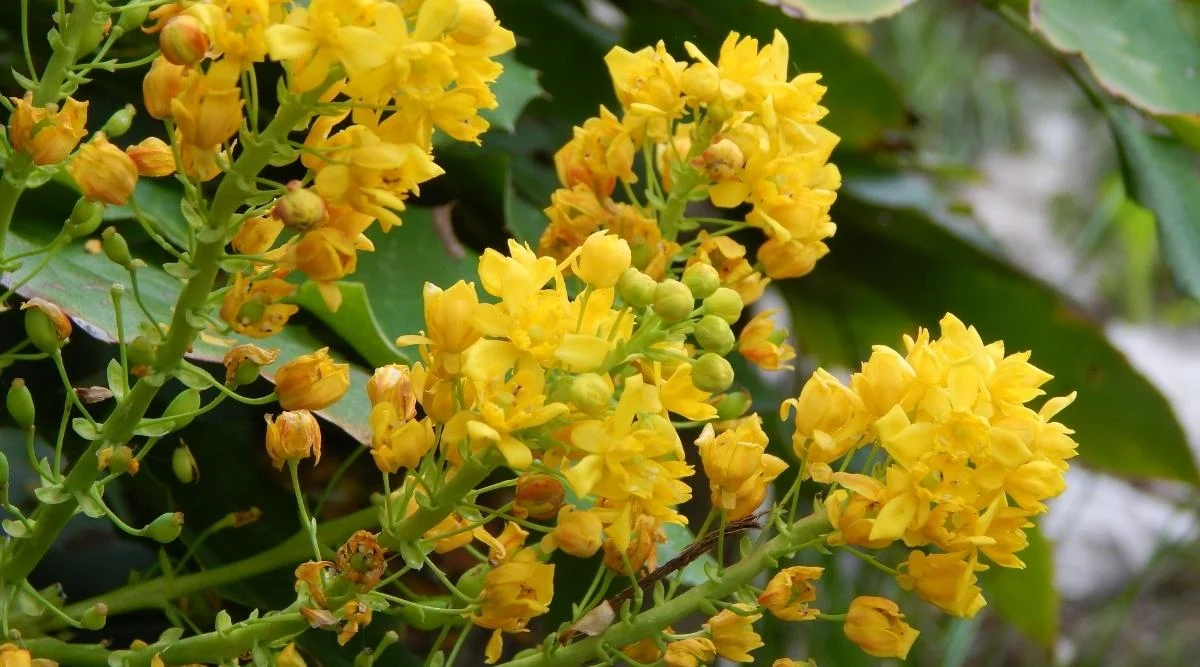natostratcon.info – Creeping Mahonia (Mahonia repens), also known as “Oregon Grape,” is an evergreen groundcover plant prized for its attractive foliage, vibrant flowers, and adaptability to a variety of garden conditions. Native to the western United States, Creeping Mahonia is an excellent choice for gardeners looking for a hardy, low-maintenance plant that adds both beauty and ecological benefits to their landscape.
Description and Features
Creeping Mahonia is a low-growing, spreading shrub that typically reaches heights of 1 to 2 feet, with a spread of up to 3 feet. It has glossy, dark green leaves that are pinnately compound, meaning each leaf is made up of several smaller leaflets. In the fall and winter, the leaves often take on reddish or purple hues, providing year-round interest.
In early spring, Creeping Mahonia produces clusters of small, bright yellow flowers. These flowers are tubular and grow in dense, upright racemes. The blooms are fragrant and attract pollinators like bees and butterflies, making them a valuable addition to pollinator-friendly gardens. Following the flowers, the plant produces blue-purple berries, which resemble grapes and are a favorite food of birds and small mammals.
Creeping Mahonia is also known for its leathery leaves, which are spiny along the edges, giving the plant a distinctive appearance. These leaves, combined with the plant’s bright flowers and berries, make Creeping Mahonia a striking addition to any garden.
Habitat and Distribution
Creeping Mahonia is native to the Pacific Northwest of the United States, where it is commonly found growing in woodlands, along forest edges, and in rocky, shaded areas. It thrives in moist, well-drained soil and prefers partial to full shade, although it can tolerate some sun, especially in cooler climates.
This hardy plant is particularly well-suited for garden situations where other plants might struggle, such as shady areas, under trees, or on slopes. Creeping Mahonia is drought-tolerant once established, making it ideal for xeriscaping and low-maintenance garden designs.
Ecological Importance
Creeping Mahonia plays an important role in supporting local ecosystems. The bright yellow flowers attract bees, butterflies, and other pollinators, while the blue-purple berries provide a food source for birds, especially in the winter months when other food is scarce. This makes Creeping Mahonia an excellent plant for wildlife gardens and for supporting biodiversity.
In addition, Creeping Mahonia’s dense foliage helps control soil erosion, making it a valuable groundcover on slopes and in areas prone to erosion. Its ability to grow in shaded conditions also makes it an excellent choice for underplanting in wooded areas or around trees, where few other plants can thrive.
Cultivation and Care
Creeping Mahonia is relatively easy to grow and care for, making it an excellent choice for both beginner and experienced gardeners. It thrives in acidic, well-drained soil, and while it prefers shady areas, it can tolerate some direct sunlight, particularly in cooler climates.
Once established, Creeping Mahonia is fairly drought-tolerant, though it benefits from regular watering during dry periods, especially in its first year of growth. It’s important to avoid overwatering, as the plant does not like to sit in soggy soil.
Creeping Mahonia requires little maintenance once established, but periodic pruning may be necessary to keep it from becoming too leggy or to remove any dead or damaged growth. This plant is generally pest-resistant, though it may occasionally attract aphids or scale insects.
For propagation, Creeping Mahonia can be grown from seed, but it is more commonly propagated through division or by taking cuttings. These methods ensure that the plant maintains its characteristics and grows true to type.
Symbolism and Cultural Significance
Creeping Mahonia, with its vibrant yellow flowers and resilience in tough growing conditions, has a cultural significance in Native American traditions. The plant has been used for medicinal purposes by indigenous peoples, particularly for its roots, which were believed to have various healing properties. The berries, though not typically eaten raw due to their tartness, were sometimes used to make jams, jellies, or medicinal teas.
Symbolically, Creeping Mahonia is often associated with strength, resilience, and protection. Its ability to thrive in difficult conditions and provide food and shelter for wildlife reflects its symbolic meaning of endurance and sustainability.
Conclusion
Creeping Mahonia is a unique and beautiful groundcover plant that offers a range of benefits for any garden. With its evergreen foliage, vibrant yellow flowers, and attractive berries, it provides year-round interest and is a valuable addition to wildlife gardens. Its adaptability to shade, drought tolerance, and ability to support pollinators make it an excellent choice for sustainable landscaping and low-maintenance garden designs. Whether used to cover the ground in a woodland garden or as a decorative element in a shaded corner, Creeping Mahonia continues to captivate gardeners with its beauty and ecological value.
